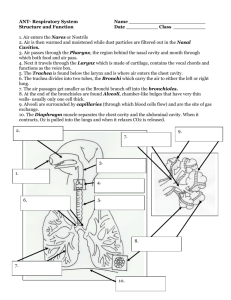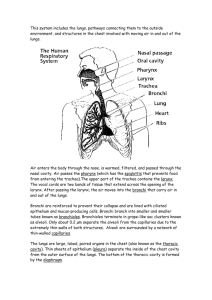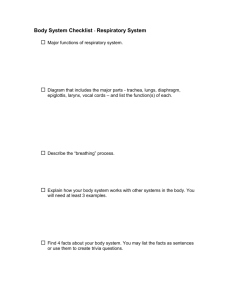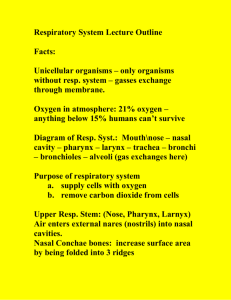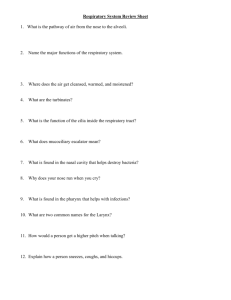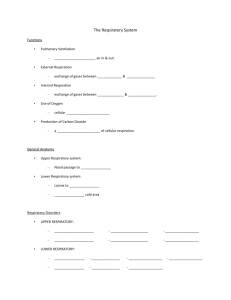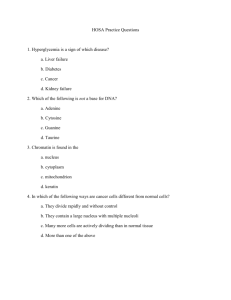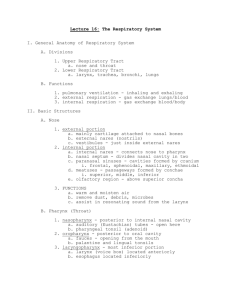lab1 - Java JAVAC
advertisement
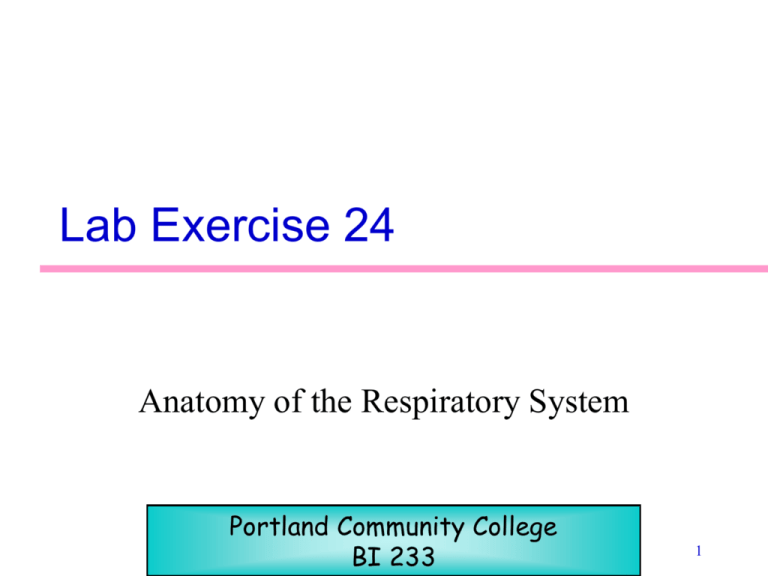
Lab Exercise 24 Anatomy of the Respiratory System Portland Community College BI 233 1 Introduction • Provides oxygen to the cells of the body and removes carbon dioxide Upper & Lower Respiratory System Upper Respiratory System Nose Nasal cavity Paranasal sinuses Pharynx 3 Respiratory system Lower Respiratory System Larynx Trachea Bronchi Lungs 4 Nasal bones • Frontal and nasal bones form the nasal bridge and processes of the maxillae make up the lateral walls. • Nasal septum divides the nasal cavity into right and left halves formed by vomer and perpendicular plate of the ethmoid 5 Nasal Turbinates or Conchae • Ciliated pseudostratified columnar epithelium with . goblet cells pushes trapped dust toward the back of the throat to be swallowed. 6 Nasal Cavity 7 Nasal Cavity Opening of Auditory Tube Superior Middle & Inferior Turbinates or Chonchae External Nares 8 Nasal Cavity The nasal epithelium covering the conchae serves to cleanse, warm and humidify the air • Nasal conchae increase the surface areas for the mucus epithelium The olfactory epithelium in the upper medial part of the nasal cavity is involved in the sense of smell. The nasal cavity serves as a resonating chamber as well as an avenue for escaping air. 9 Sinuses All the sinuses are continuous with the nasal cavity are lined by mucous membrane. Mucous secretions drain into the nasal cavities. 10 11 12 13 14 15 16 17 18 19 20 Pharynx • Connects the nasal and oral cavities to the larynx and esophagus • Anatomically divided into 3 sections: 1. Nasopharynx 2. Oropharynx 3. Laryngopharynx 21 Pharynx 22 Uvula • During swallowing, the soft palate elevates and the uvula closes off the internal nares, preventing food or fluids from entering the nasal cavity. 23 Tonsils Pharyngeal Tonsils (Adenoids) Palatine Tonsils Lingual Tonsils 24 Tonsils Pharyngeal tonsils • Tonsils: lymphoid tissue. Palatine tonsils 25 26 27 28 29 30 Larynx: aka Voice Box • Made of 9 pieces of cartilage, the most important are: • Thyroid cartilage (Adam’s Apple) • Thyrohyoid membrane • Cricoid Cartilage • Cricothyroid ligament • Epiglottis 31 Hyoid Bone Larynx Epiglottis Thyroid Cartilage Cricoid Cartilage Thyrohyoid Membrane Thyrohyoid ligament Cricothyroid Ligament Tracheal Cartilage 32 Inside the Larynx • Vestibular Folds: • Also called false vocal cords, ventricular band of larynx, ventricular folds, and upper folds • Vocal Cords, or vocal folds • Lower, “true” vocal cords • Attach to the arytenoid cartilages by the vocal ligaments (internal) • Glottis: The vocal cords and the space (rima glottidis) between them. 33 Inside the Larynx 34 Inside the Larynx Rima Glottidis True Vocal Cords Glottis Epiglottis Tongue 35 Glottis: True cords plus opening Rima Glottidis = The opening 36 https://www.youtube.com/watch?v=pNcV6yAfqg Swallowing 8secs in https://www.youtube.com/watch?v=iYpDwhpILk Q Larynx 30secs in https://www.youtube.com/watch?v=XGds2GAvGQ first 45 secs 37 Larynx Airways Trachea The carina is the last cartilage which separates the entrances to the left and right primary bronchi Right Mainstem Bronchi Left Mainstem Bronchi Secondary Bronchi Carina Secondary Bronchi 38 Bronchi • The carina of the last tracheal cartilage marks the end of the trachea and the beginning of the right and left bronchi • Left main stem bronchus • Right main stem bronchus • Bronchi subdivide into secondary bronchi, each supplying a lobe of the lungs 39 Respiratory Tree 40 Branching of Bronchial Tree Trachea Primary Bronchi Secondary Bronchi Tertiary Bronchi Bronchioles Terminal/Respiratory Bronchioles 41 Lungs • • • • Apex: the part under the clavicle Base: the part touching the diaphragm Costal Surface: the part touching the ribs Hilus: indentation containing pulmonary and systemic blood vessels • Left Lung has 2 lobes and a cardiac notch • Left upper lobe • Left lower lobe • Right Lung has 3 lobes • Right upper lobe, middle lobe, lower lobe 42 Apex Lungs LUL RUL Hilus RML LLL RLL Base 43 Lungs: Medial View 44 Lung Lobes 45 Pleura • Pleura is the double-layered sac of serous membrane • Parietal Pleura is the outer layer and is attached to the thoracic walls • Visceral Pleura is the inner layer covering the lung tissue • The layers are only touching, they are not fused together • The potential space is called the pleural cavity • There is serous fluid between the layers which allows them to slide against each other during breathing 46 Pleural cavity is in between the two layers 47 Mediastinum • The area between the lungs. • Posterior to the sternum • Anterior to the vertebrae • Contains the heart, great vessels, esophagus and thymus 48 Trachea Histology • Composed of three layers 1. Mucosa: made up of goblet cells and ciliated pseudostratified columnar epithelium 2. Submucosa: connective tissue deep to the mucosa 3. Adventitia: outermost layer, has C-shaped rings of hyaline cartilage 49 Trachea 50 Trachea Histology 51 Trachea Histology 52 Seromucous Glands (Trachea) 53 Trachea Pseudostratified Columnar Epithelium Submucosa with seromucous glands Hyaline Cartilage 54 Bronchi Bronchioles • Tissue walls of bronchi mimic that of the trachea • As conducting tubes become smaller, structural changes occur and eventually they become bronchioles • Cartilage support structures change • Bronchioles differ from bronchi in that they lack cartilage • Epithelium types change • Amount of smooth muscle increases 55 Bronchi Histology 56 Bronchiole Histology Notice the lack of cartilage Simple columnar epithelium 57 Bronchioles Respiratory Bronchioles • Respiratory Bronchioles : Continued branching leads to the area where gas exchange occurs by simple diffusion 58 Respiratory Bronchioles Alveolar Ducts Alveolar sacs 59 Alveolar sacs Alveoli • Alveolar sacs look like clusters of grapes • The “individual grapes” are alveoli 60 Type II Pneumocytes are cuboidal and produce surfactant Type 1 Pneumocytes are flattened for gas exchange 61 Alveoli Histology 62 63 Respiratory Membrane • The area where gas exchange between air and blood occurs • It is the fused alveolar and capillary walls (3 layers) 1. Squamous type 1 alveolar epithelium 2. Fused basal laminae 3. Squamous endothelial cells in pulmonary capillaries 64 Respiratory Membrane 65 66 67 68 69 70 71 72 73 The End • Make sure that you can identify structures on the models • Identify the structures on microscopes 74
